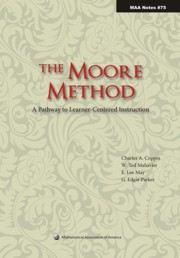Book contents
- Frontmatter
- Contents
- Dedication
- Acknowledgements
- 1 Introduction
- 2 Moore's Moore Method
- 3 What is the Moore Method?
- 4 On Culture
- 5 Development and Selection of Materials
- 6 In the Classroom
- 7 Grading
- 8 Why Use the Moore Method?
- 9 Evaluation and Assessment: Effectiveness of the Method
- 10 Frequently Asked Questions
- Appendices
- I Coppin
- II Mahavier
- III May
- IV Parker
- About the Authors
- References
- Index
IV - Parker
from Appendices
- Frontmatter
- Contents
- Dedication
- Acknowledgements
- 1 Introduction
- 2 Moore's Moore Method
- 3 What is the Moore Method?
- 4 On Culture
- 5 Development and Selection of Materials
- 6 In the Classroom
- 7 Grading
- 8 Why Use the Moore Method?
- 9 Evaluation and Assessment: Effectiveness of the Method
- 10 Frequently Asked Questions
- Appendices
- I Coppin
- II Mahavier
- III May
- IV Parker
- About the Authors
- References
- Index
Summary
Syllabus for Real Analysis
Following is an excerpt from the syllabus and introduction to the notes from a course in real analysis.
COURSE: Mathematics 410 Advanced Calculus I (An Introduction to Analysis)
INSTRUCTOR: Ed Parker
OFFICE: Burruss 001, JMU6938, [email protected]
OFFICE HOURS: MF 8–9, W 2:30–3:30, Tu 9–10, Th 10–11 (student priority, MF 2:30–3:30, W 8–9, Tu 10–11, Th 9–10 (advisee priority), or by appointment
TEXTBOOK: There will be no formal textbook. Classes will be conducted from problem sets distributed by the instructor; solutions to those problems should effectively allow the student to write his/her own text.
COURSE CONTENT: Number functions and continuity, intermediate and extreme values, derivatives, and (time permitting) integrals.
POLICIES: This course is concerned with the creation and application of the theory that supports elementary calculus. Its conduct will be studentoriented in the sense that you will be asked to create solutions to problems, present your solutions for the scrutiny of the class, and to “criticize” the work of others when presented. You may earn credit during the semester by presenting your solutions in written or oral form. Oral presentation carries twice as much credit as written presentations. A final examination covering the entire course will be given at the end of the semester. The final grade will be determined from the problems solved during the semester (both quantity and quality are factors) and from the final examination.
- Type
- Chapter
- Information
- The Moore MethodA Pathway to Learner-Centered Instruction, pp. 217 - 228Publisher: Mathematical Association of AmericaPrint publication year: 2009

